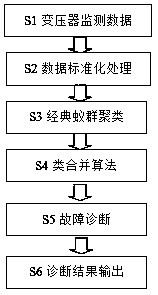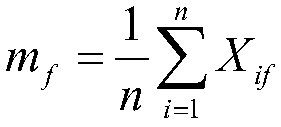A method and system for early diagnosis and early war of transformer fault
A transformer fault and early diagnosis technology, applied in prediction, instrumentation, calculation models, etc., can solve problems such as outliers, data objects not assigned to a certain class, etc., and achieve the effect of improving efficiency
- Summary
- Abstract
- Description
- Claims
- Application Information
AI Technical Summary
Problems solved by technology
Method used
Image
Examples
Embodiment 1
[0074] If the distance between two classes is the smallest, then the two classes can be considered to be aggregated into one class. And each class is an area. When calculating the distance between classes, the distance between the center points of the two classes is calculated. The distance between the two classes is the smallest and the two classes can be merged, namely:
[0075] In S4, merging the classes with high similarity and outliers in the clustering results includes:
[0076] S411, calculating the distance D between each type and each outlier point and the center point of other adjacent classes or outlier points in the results of the classic ant colony clustering algorithm of S3;
[0077] S412, setting the minimum class number threshold, if the total number of current class and outlier points is greater than the minimum class number threshold, then merge the two classes or two outlier points or classes and outlier points with the smallest distance, and recalculate Fo...
Embodiment 2
[0080] In order to speed up the rapid diffusion of clusters from the high-density area to the outside, the class merging algorithm in this embodiment is: arrange all the distances from small to large, when the distance D i and the previous distance D i-1 When the ratio of is less than the threshold σ, the distance D i as with D i The two types of related merging ties. which is:
[0081] In S4, merging the classes with high similarity and outliers in the clustering results includes:
[0082] S421, calculating the distance D between each type and each outlier point and other adjacent classes or outlier points in the result of the S3 classic ant colony clustering algorithm;
[0083] S422. Sorting the calculated multiple distances D according to their size;
[0084] S423, calculate any distance D i The ratio between the adjacent and smaller distance, if the ratio is less than the preset threshold σ, the distance D i The corresponding two classes or two outliers or classes a...
Embodiment 3
[0094] This embodiment is a specific implementation of steps S3 and S4, using the merging algorithm described in Embodiment 1, and its pseudocode is as follows:
[0095] ①In the initialization algorithm, the number of ants m, the number of data objects n, the maximum number of iterations T, the grid side length Z, the local side length s and other related parameters; the more the number of ants, the higher the clustering efficiency, and the object That is, the transformer monitoring data; the specific relevant parameters are as follows:
[0096] Table 1 Algorithm related parameters
[0097]
[0098]
[0099] ② Perform data preprocessing on the fault gas characteristic data;
[0100] ③ Randomly project data objects and ants into a two-dimensional grid, and only one object is allowed in a grid;
[0101] ④Repeat and iterate the following process:
[0102] For t=1 to T do{
[0103] For i=1 to m{
[0104] Calculate the number of data objects in the neighborhood of ant i wi...
PUM
 Login to View More
Login to View More Abstract
Description
Claims
Application Information
 Login to View More
Login to View More - R&D Engineer
- R&D Manager
- IP Professional
- Industry Leading Data Capabilities
- Powerful AI technology
- Patent DNA Extraction
Browse by: Latest US Patents, China's latest patents, Technical Efficacy Thesaurus, Application Domain, Technology Topic, Popular Technical Reports.
© 2024 PatSnap. All rights reserved.Legal|Privacy policy|Modern Slavery Act Transparency Statement|Sitemap|About US| Contact US: help@patsnap.com










